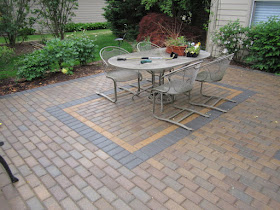Brick pavers patios, walks, and driveways
Brick Pavers in the last 30 years has evolved into one the most popular pavement options in the Midwest. The aesthetics and functional value of brick pavers make it the best financial choice for patios, walks, and driveways. For purpose of this article, I will discuss grade (ground) level options and exclude elevated structures that compete with composite decks or landings. In the Midwest, there are many challenges to pavement performance, mainly from the freeze thaw cycles (ground frost) we experience.
 The initial cost of installing brick pavers will exceed most cement and asphalt pavements. Stamped concrete costs will be closer to the cost of a brick paver installation, but a variety of high end designed pavers will keep costs higher. Brick paver manufacturers have spent incredible investment funds for research to improve the density, appearance, and performance of brick pavers. Customer needs have changed over the past 30 years and meeting that need has improved the brick paver industry's response by giving many design, color, and texture options for homeowners.
The initial cost of installing brick pavers will exceed most cement and asphalt pavements. Stamped concrete costs will be closer to the cost of a brick paver installation, but a variety of high end designed pavers will keep costs higher. Brick paver manufacturers have spent incredible investment funds for research to improve the density, appearance, and performance of brick pavers. Customer needs have changed over the past 30 years and meeting that need has improved the brick paver industry's response by giving many design, color, and texture options for homeowners.
The
cost of a brick paver installations have doubled over the past 15 years, mainly due to the cost of labor. The
brick paver market is a skilled labor that cannot be efficient or qualitative if done by a standard landscape crew. Admittedly, it is not as skilled as masonry installations, but it takes an experienced and creative crew to execute the specifications and quality installation of todays
brick paver designs. General labor is still needed but this work is physical and time consuming. Most
brick pavers are installed for residential applications and each individual brick paver is handled and installed. Mass installation of
pavers by specialized equipment typically is reserved for large commercial or municipal applications. Costs for base material has skyrocketed due the cost of mining and shipping. Base materials are used for the base prep as well as the production of the
asphalt, concrete, and brick pavers.
The cost advantage of
brick pavers installation comes over time! All pavements require some maintenance but asphalt requires the most frequent attention of surface maintenance and replacement. Cement can be quiet for about 5 years in the Midwest but once cracks, shifting, and spalling occur, maintenance begins to accelerate for this pavement. Replacement is the highest cost for cement pavements. You can choose to do ongoing maintenance of crack filling, re-leveling, and staining but the aesthetic value declines considerably after 5 years.
Brick pavers on the other hand give you the best value on costs over 10+ years. Brick pavers do require some ongoing maintenance like sanding joints & sealing (optional) but these costs are nominal. The aesthetic value is unmatched by other pavements as you can choose a design maximizing creative design, textures, and colors. The functional value of brick pavers is the best pavement option for the Midwest's frequent freeze thaw cycle which moves or flexes all pavements during the Winter and early Spring. I do not care how deep you prepare your base material for any pavement option, the earth will decide what it's going to do! The beauty of brick pavers is that they have more flexibility to the movements of ground frost than asphalt and cement. Brick pavers can easily be reset and do not require the replacement of the pavement over the long term. Properly maintained brick paver applications like patios, walks, and driveways can last over 30 years before replacement may be considered.


